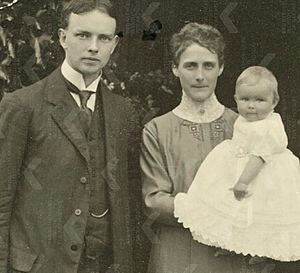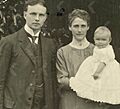Beatrice Boeke-Cadbury facts for kids
Quick facts for kids
Beatrice Boeke-Cadbury
|
|
|---|---|

Kees Boeke and Beatrice Boeke-Cadbury, June 1913
|
|
| Born |
Beatrice Cadbury
|
| Other names | Betty Boeke, Beatrice Boeke |
| Spouse(s) | Kees Boeke |
Beatrice Boeke-Cadbury (born April 28, 1884 – died February 13, 1976) was an amazing English-Dutch woman. She was a social activist, a teacher, and a Quaker missionary. She is famous for helping and hiding Jewish children during World War II. For this brave work, she was later honored as one of the Righteous Among the Nations. This special title is given to people who risked their lives to save Jews during the Holocaust.
Contents
Beatrice's Early Life
Growing Up in a Quaker Family
Beatrice Cadbury was born into the wealthy Cadbury chocolate family. Her parents were Richard Cadbury and Emma Richard Cadbury. She grew up in a Quaker home. Quakers are a religious group known for their simple lifestyle and belief in peace.
Beatrice went to Westfield College in London. She became involved with the Friends' Foreign Mission Association (FFMA). This group helped people in other countries. Through her work, she met her future husband, Cornelius "Kees" Boeke. They got married on December 19, 1911. From 1912 to 1914, they worked as Quaker missionaries in Syria.
Standing Up for Peace
When World War I began, Beatrice and Kees returned to England. Kees Boeke was a teacher, but he lost his job. He was fired because he believed in peace and spoke out against war. He also protested against people being forced to join the army. Because of his views, he was put in prison. In 1918, he was sent back to the Netherlands.
In the 1920s, Beatrice and Kees continued to protest. They joined groups who disagreed with how governments worked. They had eight children between 1912 and 1927. Beatrice later returned to the Quaker faith.
Sharing the Cadbury Fortune
Beatrice's family wealth helped support their work. In 1921, she and Kees gave up their shares in companies. They believed that everyone should be equal and didn't agree with owning a lot of property.
However, their friends and workers from the Cadbury factory helped them. They set up a special fund to support Beatrice's family and their projects. Beatrice even gave many of her shares to the Cadbury workers. Kees also refused to pay taxes. He didn't want his money to be used for military spending. This sometimes made their lives difficult. They also believed that no one should truly "own" land. This led to them being asked to leave their homes several times.
Education Reform and Resistance
Starting Their Own School
Because Beatrice and Kees didn't pay taxes, their children couldn't go to regular schools. So, in 1926, they decided to start their own school. It was called the Werkplaats Kindergemeenschap. This means "Workshop Children's Community." It was located in Bilthoven, Netherlands. Beatrice also taught English at the school.
Helping During World War II
In 1938, the school began to help German-Jewish children. These children were refugees, meaning they had fled from Nazi Germany. The Nazis were persecuting Jewish people. In 1941, the Nazis ordered schools in the Netherlands to separate children by race. Beatrice wanted to close their school. But Kees convinced her that they could do more good by keeping it open. Beatrice also taught at a private Jewish school in Loosdrecht.
In late 1942, Beatrice and Kees started hiding children. They took in nine-year-old Norman Magnus and his six-year-old sister Anita. The children had fake papers and new names to hide their true identities. Later, two more of their sisters also stayed with the Boeke family. They stayed until 1944. During this time, Kees and others from the school were arrested and questioned. Two of their employees were even killed by the Nazis. But no one ever revealed where the children were hidden. This shows how brave and dedicated Beatrice and Kees were.
After the War
After World War II ended, the Werkplaats school became very famous. Even Dutch princesses Beatrix, Irene, and Margriet attended the school.
In the 1950s, Beatrice and Kees moved to Lebanon. They wanted to start a school there for Arab refugees. But Beatrice became ill, so they soon returned to the Netherlands.
Special Recognition
In June 1991, a sculpture of Beatrice Boeke-Cadbury was made. It was created by Fokke de Hoog for a reunion of the Werkplaats school.
On July 4, 1991, Beatrice and her husband Kees were officially recognized by Yad Vashem. This organization honors people who saved Jews during the Holocaust. They were named Righteous Among the Nations. Their names are remembered on the Wall of Honor.
See also
- List of peace activists
Images for kids


